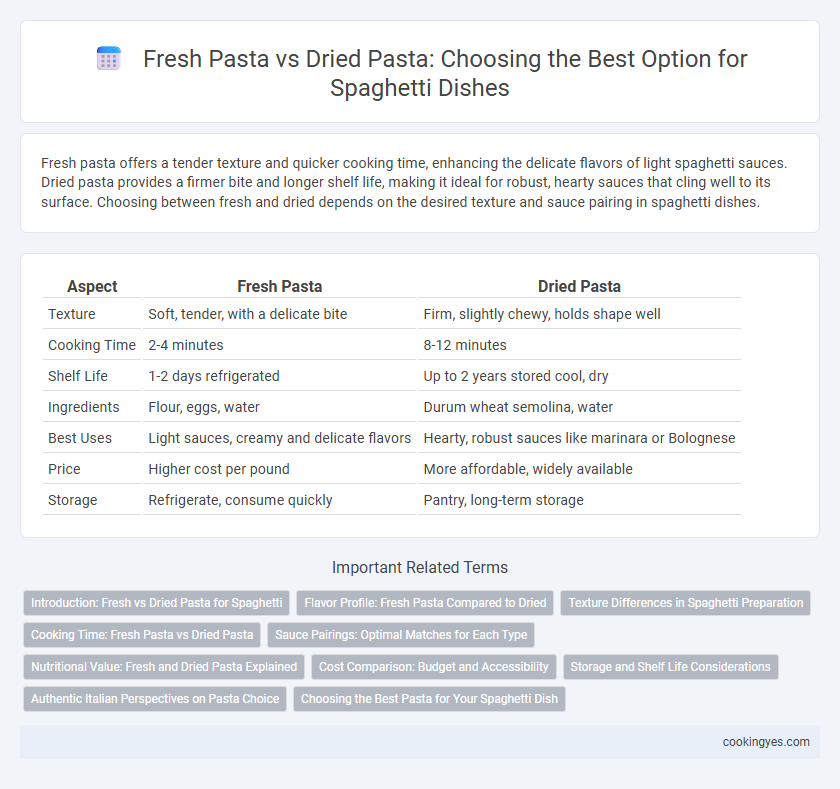Fresh pasta offers a tender texture and quicker cooking time, enhancing the delicate flavors of light spaghetti sauces. Dried pasta provides a firmer bite and longer shelf life, making it ideal for robust, hearty sauces that cling well to its surface. Choosing between fresh and dried depends on the desired texture and sauce pairing in spaghetti dishes.
Table of Comparison
| Aspect | Fresh Pasta | Dried Pasta |
|---|---|---|
| Texture | Soft, tender, with a delicate bite | Firm, slightly chewy, holds shape well |
| Cooking Time | 2-4 minutes | 8-12 minutes |
| Shelf Life | 1-2 days refrigerated | Up to 2 years stored cool, dry |
| Ingredients | Flour, eggs, water | Durum wheat semolina, water |
| Best Uses | Light sauces, creamy and delicate flavors | Hearty, robust sauces like marinara or Bolognese |
| Price | Higher cost per pound | More affordable, widely available |
| Storage | Refrigerate, consume quickly | Pantry, long-term storage |
Introduction: Fresh vs Dried Pasta for Spaghetti
Fresh pasta offers a tender texture and delicate flavor that absorbs light sauces well, making it ideal for simple, fresh ingredients like tomatoes and basil. Dried pasta provides a firmer bite and longer shelf life, excelling in hearty, robust sauces such as Bolognese or marinara. Choosing between fresh and dried pasta depends on the desired texture and sauce pairing for the perfect spaghetti dish.
Flavor Profile: Fresh Pasta Compared to Dried
Fresh pasta for spaghetti dishes offers a tender, delicate texture with a slightly sweet, egg-rich flavor that enhances lighter sauces like olive oil or cream-based varieties. Dried pasta, made from durum wheat, presents a firmer, chewier bite and a more neutral wheat taste that robustly holds up to hearty, tomato-based or meat sauces. Choosing fresh pasta highlights subtle, nuanced flavor profiles, while dried pasta delivers a consistently hearty backbone for bold, intense flavors in traditional spaghetti recipes.
Texture Differences in Spaghetti Preparation
Fresh pasta offers a tender, silky texture that absorbs sauces more evenly, enhancing the overall mouthfeel of spaghetti dishes. Dried pasta provides a firmer, al dente bite that maintains its shape and delivers a satisfying chew, ideal for robust, hearty sauces. Choosing between fresh and dried pasta significantly influences the texture profile, catering to preferences for softness versus firmness in spaghetti preparation.
Cooking Time: Fresh Pasta vs Dried Pasta
Fresh pasta cooks significantly faster than dried pasta, typically requiring only 2 to 4 minutes to reach al dente, while dried pasta usually needs 8 to 12 minutes depending on thickness. The high moisture content in fresh pasta reduces cooking time and results in a tender texture, whereas dried pasta, with its low moisture and firm structure, takes longer to absorb water and soften. Choosing between fresh and dried pasta impacts meal preparation speed and texture, making fresh pasta ideal for quick meals and dried pasta better suited for longer cooking recipes.
Sauce Pairings: Optimal Matches for Each Type
Fresh pasta's tender texture and delicate flavor pair exceptionally well with light, creamy, or seafood-based sauces such as Alfredo, carbonara, or garlic butter, which complement its subtle taste without overpowering it. Dried pasta's firmer bite and robust structure hold up better to hearty, tomato-based sauces like marinara, Bolognese, or arrabbiata, allowing the pasta to retain shape and texture during prolonged cooking. Selecting the right pasta type enhances the overall dish by balancing sauce absorption and mouthfeel, ensuring an optimal spaghetti dining experience.
Nutritional Value: Fresh and Dried Pasta Explained
Fresh pasta generally contains more moisture and fewer preservatives, which results in a softer texture and slightly higher protein content, while dried pasta offers greater shelf stability and typically has a longer cooking time. Nutritionally, dried pasta often provides more fiber and complex carbohydrates due to its lower water content, making it a preferred choice for sustained energy release in spaghetti dishes. Both types deliver essential nutrients like iron and B vitamins, but fresh pasta may have a slight edge in terms of freshness and richness in some micronutrients.
Cost Comparison: Budget and Accessibility
Fresh pasta typically costs more than dried pasta due to higher production and preservation requirements, making dried pasta a more budget-friendly option for spaghetti dishes. Dried pasta offers extended shelf life and greater accessibility in most grocery stores, allowing consumers to stock up economically. For cost-conscious cooks, dried pasta provides an affordable, convenient base without sacrificing the classic texture essential to spaghetti recipes.
Storage and Shelf Life Considerations
Fresh pasta for spaghetti requires refrigeration and typically has a shelf life of 2 to 3 days, making it ideal for immediate use but limited storage. Dried pasta offers the advantage of room temperature storage with a shelf life of up to two years, providing convenience and longer-term availability. Choosing between fresh and dried pasta depends on meal planning needs and storage capabilities to maintain optimal quality and flavor.
Authentic Italian Perspectives on Pasta Choice
Authentic Italian perspectives emphasize that fresh pasta offers a delicate texture and absorbs sauces more readily, ideal for lighter, subtle spaghetti dishes like aglio e olio. Dried pasta, made from durum wheat semolina, provides a firmer bite and holds up well with robust, hearty sauces such as Bolognese or arrabbiata. Regional traditions in Italy often dictate the pasta choice, with northern cuisine favoring fresh pasta while southern regions prefer dried varieties for their durability and flavor intensity.
Choosing the Best Pasta for Your Spaghetti Dish
Fresh pasta offers a tender texture and absorbs sauces quickly, making it ideal for delicate or creamy spaghetti dishes, while dried pasta provides a firmer bite and longer shelf life, perfect for robust, tomato-based sauces. Choosing between fresh and dried pasta depends on the sauce intensity and cooking time, as fresh pasta cooks faster and pairs well with light coatings. For classic spaghetti Bolognese or aglio e olio, dried pasta maintains structural integrity, ensuring an authentic and satisfying bite.
Fresh pasta vs Dried pasta for spaghetti dishes Infographic

 cookingyes.com
cookingyes.com